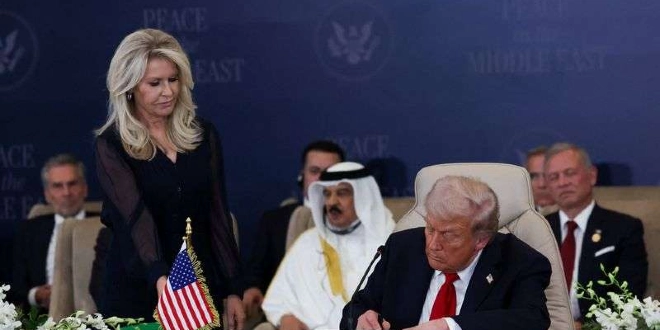Hamas has released the last of the living Israeli hostages under a historic ceasefire deal, while Israel began freeing thousands of Palestinian detainees in a major step toward ending nearly two years of devastating conflict in Gaza. The announcement came as U.S. President Donald Trump delivered a triumphant address to Israel’s parliament, declaring that “peace has arrived in the Holy Land.”
The Israeli military confirmed that all 20 surviving hostages had been safely handed over by the Red Cross and were now back in Israel. The news sparked scenes of joy and relief in Tel Aviv, where thousands gathered at “Hostage Square” to celebrate, many hugging and crying as they learned their loved ones were finally free.
In Gaza, the atmosphere mirrored that emotion. Crowds of Palestinians flooded the streets and hospitals, cheering as buses arrived carrying some of the nearly 2,000 prisoners and detainees released by Israel under the U.S.-brokered deal.
“The skies are calm, the guns are silent, and the sirens are still,” Trump said in his address to the Knesset. “The sun rises on a Holy Land that is finally at peace.”
A U.S.-Brokered Breakthrough
The agreement marks the first major breakthrough in peace efforts since the war began on October 7, 2023, when Hamas-led militants killed around 1,200 Israelis and took 251 hostages in a surprise attack. The Israeli military’s subsequent offensive left more than 68,000 Palestinians dead and reduced much of Gaza to rubble.
The United States, alongside Egypt, Qatar, and Turkey, helped mediate the deal, which includes a ceasefire, phased withdrawals of Israeli troops from Gaza, and the mutual release of hostages and prisoners.
Trump later arrived in Egypt’s resort city of Sharm el-Sheikh, where he joined President Abdel Fattah al-Sisi and more than 20 world leaders at a summit aimed at consolidating the truce and outlining the next steps for regional peace. Large billboards featuring Trump and Sisi, captioned “Welcome to the Land of Peace,” lined the roads leading to the venue.
At the summit’s opening, Trump signed a document formalizing the ceasefire alongside representatives from Egypt, Qatar, and Turkey, describing it as the “first step toward lasting stability in the Middle East.”
Aftermath of War and the Road to Recovery
The ceasefire halted Israel’s most intense assault of the conflict — a massive operation in Gaza City that had killed hundreds daily. Since the truce took effect, tens of thousands of Palestinians have begun returning to what remains of their homes. The destruction is overwhelming, with vast areas flattened by airstrikes and artillery.
While the hostage and prisoner exchanges mark a significant milestone, many challenges remain before a durable peace can take hold. Israel is still working to recover the remains of 26 hostages believed to have died in captivity, while the fates of two others remain unknown. Hamas said it would hand over four bodies, and Israeli officials later confirmed that two had already been returned.
Meanwhile, humanitarian conditions in Gaza remain dire. UN aid chief Tom Fletcher warned that “hundreds of thousands of people are on the brink of famine” and urged for the rapid delivery of shelter materials, fuel, and medical supplies.
Challenges Ahead: Disarmament and Governance
Key questions remain unresolved — including who will govern Gaza and how Hamas will fit into the new regional framework. Although Israel insists that Hamas must disarm, the militant group continues to assert its authority. According to Palestinian sources, Hamas fighters recently conducted a violent crackdown in Gaza City, killing 32 members of a rival faction after Israeli troops withdrew.
Speaking en route to the region, Trump acknowledged Hamas’s temporary role in maintaining order under the terms of the truce. “They want to stop the problems, and they’ve been open about it. We gave them approval for a period of time,” he said.
The war’s repercussions have reshaped the Middle East, spilling into neighboring conflicts. Israel’s 12-day confrontation with Iran and military strikes against Hezbollah in Lebanon and Houthi rebels in Yemen have heightened regional tensions. Trump hinted at a broader peace initiative, even suggesting the possibility of an agreement between Israel and Iran. “Wouldn’t it be nice?” he mused during his Knesset address.
Emotional Reunions and Lingering Pain
As freed hostages returned home, Israel witnessed emotional scenes. Two men waved from vans on their way to a hospital, one lifting an Israeli flag before forming a heart with his hands. Families who had waited months for news received phone calls confirming their loved ones were safe.
“I’m so excited, full of happiness,” said Viki Cohen, whose son Nimrod was among the released. “I didn’t sleep all night. It’s hard to believe this moment is real.”
Across the border, Palestinians in Khan Younis gathered by the thousands to welcome released prisoners. Many waved Palestinian flags and held up photos of relatives who remained missing or dead. “I’m happy for our sons who came home,” said Um Ahmed, a resident of Gaza, her voice breaking with emotion. “But we are still in pain for all those killed and for the destruction of our homes.”
Armed Hamas fighters were seen among the crowds, a reminder of the complex reality still facing the region. Israel confirmed that it had released 1,700 Gazan detainees and 250 prisoners convicted or accused of security-related crimes, including attacks on Israelis.
In Ramallah, Dr. Samer Halabeya, freed after serving time for plotting an attack that wounded an Israeli officer, stood beside his mother in tears. “We hope that everyone gets freed,” he said simply.
The scenes of joy, relief, and uncertainty reflect both the promise and fragility of this moment — a fragile peace in a land long defined by conflict.
 The Daily Star Ireland
The Daily Star Ireland

